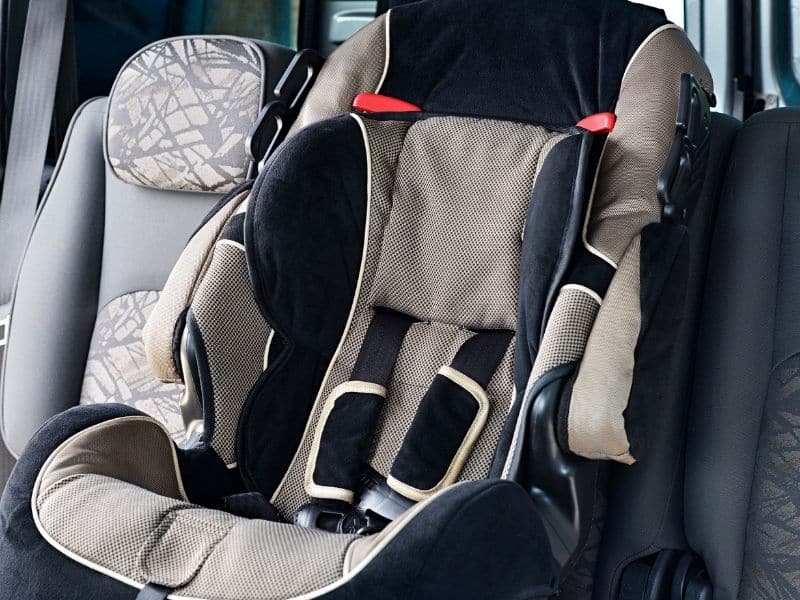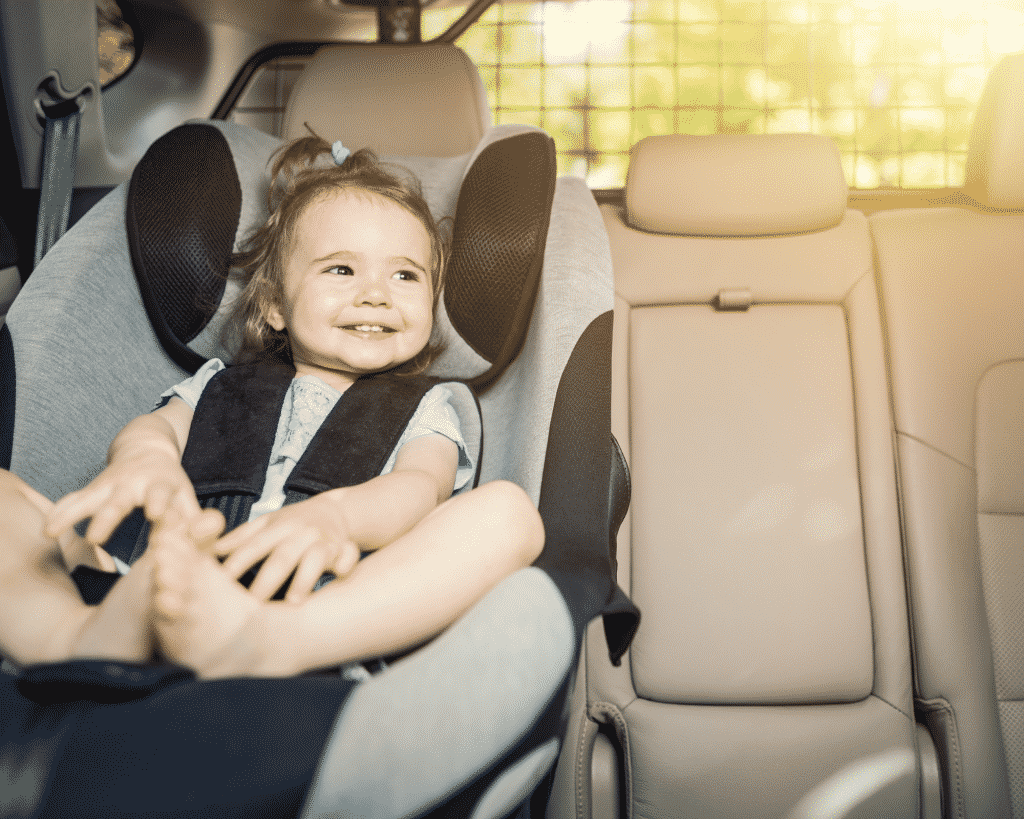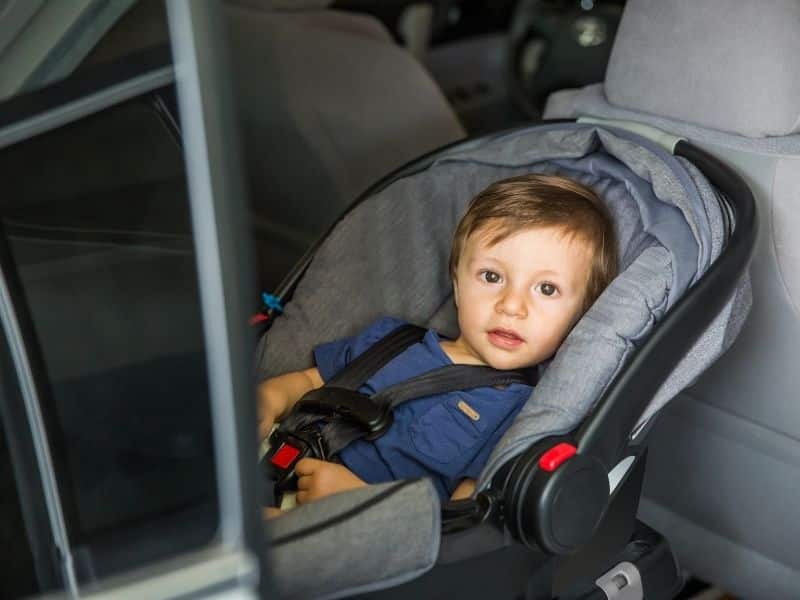A whole orange will float. A peeled orange will sink.
The density of polypropylene (plastic used to make car seats) is between a whole and a peeled orange.

My point?
There’s more to whether baby car seats float than a simple yes or no.
A direct answer like that does exist, and we’ll get to it in a minute, but a responsible parent NEEDS to know more because there are 1,500 water-related car incidents and 600 deaths every year.
That should give you a jolt.
Bottom line – there are more immediate questions than whether a car seat floats.
Let’s get some context.
Step Zero – ask the maker of the car seat
The most straightforward approach to choosing a car seat that floats is to ask the manufacturer before buying the seat.
If this works, Bob’s your uncle.
The reality of that scenario is that you’re not likely to get a straight answer because it would come with legal implications.
Even if the car seat does float, the chances of the company saying it unequivocally are slim to none.
It’s like those winter boots that are marked “for dry weather,”…
….except the boot company is risking a refund and the car seat maker a multi-million dollar lawsuit.
Bottom line – the chances of them uttering it are low…and it makes sense; I’ll explain why in a minute.
You might also be interested in: car seat do’s and don’ts, how to tether a car seat without anchors, proper car seat strap placement
Buoyancy of car seat materials
Here’s the physics of the matter – objects less dense than water will float, and those denser will sink (
There’s also the little matter of the displaced liquid force (Archimedes’ principle), but the shapes and sizes of infant car seats aren’t different enough for that to be a major factor.
K, let’s get back on track…
Remember the orange?
Yeah…so it floats when whole and sinks when peeled because its density goes from 0.84 to 1.16 ( g/cm3 – grams per cubic centimeter).
The density of water is approximately 1 g/cm3.
Note: I’ll stick with the metric system because one gram per cubic centimeter is 0.036127292 pounds per cubic inch, so it would be a mess to do that math. You don’t need to understand the metric system; just remember that anything with a density of over 1 sinks.
Why child car seats float – density of the unit as a whole
Of course, there’s no such thing as “density of a car seat.”
There are, however, determining factors to whether a baby car seat will float:
- The density of the plastic used for the shell (polypropylene) – it’s in the range of 0.9 to 0,92. On its own, it would float.
- How much metal is in the seat and where it’s distributed (buckles, seat belts, frames, stabilizing rods)
- How much water can the padding absorb?
You might also want to read: car seat foam
It’s already getting too complicated, amirite?
I took the time to define the rules so that we know which ones to focus on.
I also promised a straight answer.
So, does a child car seat float?
Yes, most child car seats float.
But there’s no way of knowing how they will float and if they’ll turn to the side or upside-down.
Confusion surrounding car seat types and brands
I’ve also seen this as a separate question pop in my inbox…
Do baby car seats float?
Yes, baby car seats float.
At least most of them. I’m guessing people ask these two questions separately because of the difference in size and contact surface compared to a convertible seat or a booster seat.

It’s not about that – the primary factor is still the density of the plastic…and that floats.
I’ve also seen people ask about specific brands of infant cars, like “Do Graco and Britax Car Seats Float?”
Yes, they do.
I’ve seen no evidence of substantial differences in buoyancy between brands.
For the purposes of this guide, I’ll use the terms “baby, infant, and child car seat” interchangeably.
You might also be interested in: how long can a newborn be in a car seat, types of car seats by age, infant car seats vs convertible car seats
Don’t rely on floating infant car seats – know what to do and have a plan
This is the meat of this guide – we’ll go over the best practices, plans to have in place for a water crash and choose a baby seat that can help (in ways beyond floating).
1 – Don’t think, get out!
If you crash into the water with a baby in the car, your first goal is to get everyone out of the car as swiftly as possible.
This might sound like a phrase, but people in these accidents share that the shock delays the decision. You might feel like there’s still something you can do to keep your car from sinking.
There isn’t.
The time to make that decision is right now.
This is where the car seat’s buoyancy comes in. If you go with a car seat that floats, you can cut the buckles and get the whole unit out, and the child’s car seat will float.
If you took the baby out and tried to swim to safety with them in your hands, things get much harder, especially in fast rivers and cold water.
2 – Child car safety protocols in a water crash – SOS-GO* or PO-GO**
Experts suggest following one of these two protocols in a water crash. The key difference between the two is when you disengage the seat belts.
- SOS-GO – Stay calm, Open the doors or windows, release the Seatbelt, Get Out!
- PO-GO – Punch the seatbelt to release, Open the doors or windows, Get Out
3 – The car won’t float for long
The car’s float time can be as low as half a minute (no more than 4 minutes).

It will also likely turn turtle and land on the roof as soon as it sinks, and a submerged vehicle is a whole different beast.
You have even less than 4 minutes to create a clear exit path because the water pressure seals the car doors.
There are three options you have to create an exit path:
1 – Open the door (don’t count on this one)
You might have two ticks to open a door before the water pressure gets too much.
Be aware that it’s possible but be prepared that it probably won’t work and think about a window escape.
If you’re on the bigger side and getting out of the window is not an option, you’ll need to wait a few minutes (calmly) for the water pressures in the car to equalize before you can open the door.
ONLY do this if you’re certain that the doors haven’t been damaged and can in fact open. If you’re not, go for the windows (or the windshield as a last resort).
2 – Open the window using the electric switch or punch it out
This might not be an option if it shorts out on water contact.
If that happens, punch out the windows with a life-hammer or a spring-loaded window punch. A device like this exists in pretty much every car.
If you don’t know where yours is, find out or get a new one next time you go out.
Anyway, the windows are tempered glass and will shatter.
3 – Plan it all in your head and try it out
You’ll need to unbuckle yourself, cut the straps and release the child’s car seat so that all of you can get out of the car.
Baby car seats are hefty, so you want to know the exact path you can use to take them out.
It might be folding the passenger seat to create space to get the baby seat out.
Take out the whole seat (with the base) or carrier only?
There’s no universal answer to this.
The shallow plastic of the seat base will create a higher buoyancy force. On the other hand, the whole unit is much bulkier and will take more time to release and take out.
That brings us back to trying scenarios out to determine what works in your car. If you can’t effectively bring the whole seat out on land, imagine what that would feel like in a frenetic scenario of a water car crash.
Resume and takeaways
The key takeaway is that what you do in a water-related accident is more important than the question “do car seats float?”

Having all that information in your head and knowing exactly what you can or can’t will take 90% of the panic away.
Make a precise plan and stick to it. It’s only then that a floating car seat will make a difference.
Now, go look for that safety hammer in your car.
For more information on car seats find out what to do with an old car seat and how long your newborn can be in a car seat.

Steph is a passionate mom who co-founded Wumblers to share her parenting journey with others. She graduated from Concordia University with a masters degree in Education Technology and worked as an advisor for many years. Steph loves being a mom and wants to have more kids.
Learn more about Steph and Wumblers here.